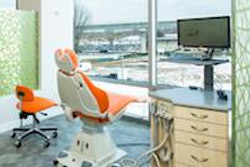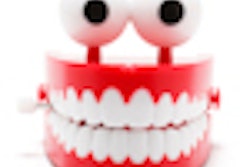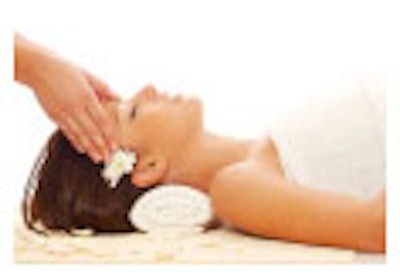
A rippling waterfall. A soothing foot massage. The scent of lavender wafting in the air. Not what you'd ordinarily expect from a trip to the dentist, even in a tourist mecca like Honolulu. And at Dr. Wynn Okuda's Dental Day Spa, that's the whole point.
"People come to us looking for something different," says Dr. Okuda, an accredited cosmetic dentist and past president of the American Academy of Cosmetic Dentistry (AACD). "We tend to attract patients who want to create a positive experience for themselves, rather than simply going to the dentist because they have to."
Dr. Okuda's motivation for creating a dental spa was as much personal as professional. As a child, he was terrified of his dentist. "I still remember the smell of cigars on his fingers and the lack of anesthetic," he says. Even worse, his dentist lived right next door. "There was nowhere to run and hide. I didn't even have the opportunity to be pried out of a car. My mother would simply drag me through the hedges and up five stairs to his office."
In 2000 Dr. Okuda decided to do something about it. "At that point in my career I realized I could help heal my own fears and anxieties about dentistry by helping to heal those of others," he says. "A lot of what the spa environment does is help counter the negatives of dentistry."
Although it's the rare practice that reaches the opulence of Dr. Okuda's, "spa" dentistry isn't a new concept. A 2004 survey by the American Dental Association found that half of all dentists now offer some kind of extras -- such as headphones, warm towels, or complimentary snacks -- while about 5 percent go the beauty salon route with massages, facials, and manicures.
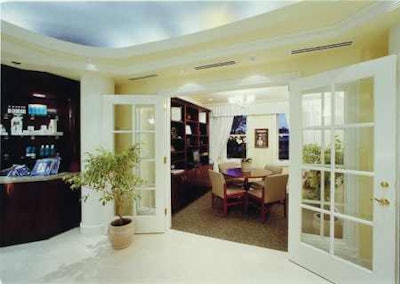 |
| Dr. Okuda's reception area and conference rooms are classy and soothing. |
A small percentage of practices offer so-called "concierge" service, skipping the frilly amenities but offering enhanced services -- such as 24/7 access to a doctor or same-day appointments for routine procedures -- to patients willing to pay a premium.
"The key difference between concierge and spa practices is access," says Dr. Cameron Jayson, chair of the Minnesota Dental Association’s Dental Marketplace Committee and a general dentist in Virginia, Minnesota. "Spa care doesn't improve a patient's access, it just adds whistles and bells. Concierge service gets doctors on the phone faster and patients in the office faster."
Why do practices do it? At minimum, it's a market differentiator - a way to show the world that your practice stands out above the rest, says Dr. David Landau, who operates Complete Dental Health in San Diego.
"It's all about the marketplace," says Dr. Landau. "Because dentistry isn't debilitatingly expensive, it's possible to pull off a high-end practice that mimics the service and feel of the Ritz Carlton or the Four Seasons."
With the right systems in place, it can also be a real money maker, says Dr. Roger P. Levin, CEO and president of Levin Group, a national practice management consultancy with offices in Arizona and Maryland.
But running a "Four Seasons" style dental practice is a riskier and more costly proposition. Hiring and training good personnel is much more difficult, and the return on investment isn't guaranteed. Sometimes going upscale can even backfire.
Atmospheric Effects
Before you can turn your House of Pain into a Palace of Pleasure, your office must look the part. For Dr. Kourosh Maddahi of Beverly Hills, that meant a floor-to-ceiling remodel. With its elegantly tiled floors, arched entries, high ceilings, and a wall lined with paintings, Dr. Maddahi's office looks more like a modern art gallery than an operatory.
"In 2000 we got rid of everything that looked or smelled like a dentist's office," says Dr. Maddahi. "We don't have before and after pictures of people's smiles on the walls, we have art. I didn't hire planners and designers who designed dental offices. I wanted my office to look like a custom home."
Similarly, Dr. Okuda uses a lot of interior real estate to help negate the invasion of personal space dentistry usually entails. His main operatory is twice the size of a typical one. The halls are wider, the ceilings higher. As a result, Dr. Okuda says many first-time patients mistake his offices for a restaurant or the lobby of a four-star hotel.
(Dr. Okuda and Dr. Maddahi declined to reveal how much they spent on remodeling their offices; another dentist who asked to remain anonymous estimates the cost of a complete spa makeover between $500,000 and $1 million.)
But the spa experience can't end when the patient travels from waiting room to dental chair or it's all for naught, says Dr. Maddahi. His practice offers exotic tea service, in-chair massage, personal movie glasses, and a limo service for out-of-town patients. Dr. Okuda's practice offers all of those amenities plus facials and aromatherapy.
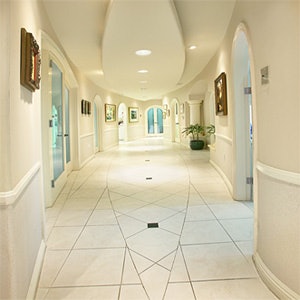 |
| The dental office as custom home: Dr. Kourosh Maddahi's Stylish Beverly Hills office is the result of a floor to ceiling remodel. |
Sometimes just a warm blanket and cookies will do quite nicely, especially if you practice in Farmington, Minnesota, like Dr. Kimberly Harms of River Edge Dental.
"We don't have a lot of limos in Farmington," says Dr. Harms, who's also a consumer advisor for the ADA. "The extras dentists offer depend a lot on where they live and the character of their community. If limos and massages are what it takes to make your patients feel comfortable, that's just fine."
Often it's the little things that make the difference. The most popular extras in Dr. Kent Smith's Dallas-area practice, 21st Century Dental, are the milk shakes he offers patients after they've undergone long procedures. For San Diego-based Dr. Landau, it's the Sony Playstation in the reception area and the diaper changing table in the bathroom.
"That was my partner Tim Collins' brainstorm," says Dr. Landau. "We get compliments on it all the time. It's the kind of thing that gets noticed."
Pick Your Patients
But the spa approach can sometimes backfire. Some patients don't go for the full-service treatment. Type A business people want to get in, get drilled, and get out, says Dr. Smith, who sees a lot of multitasking business people who work in high-tech hubs like Dallas. So you need to adjust your service offerings accordingly.
"I had a patient walk in yesterday with his laptop open in his arms while he was walking and talking on his cell phone," he says. "We put him in an operatory, he put his cell on speaker and was having a conversation while my assistant applied a topical anesthetic. We have some very time-conscious patients who rarely want to be sedated in any way, emotionally or physically. With a spa-style practice, you might lose that segment of the population."
Speed of service is very important, agrees Dr. Maddahi, who uses electric handpieces that can cut teeth more quickly, speeding up procedures by 20 percent. "If you just offer amenities -- and the quality and speed of service aren't there -- your patients will complain." Or go elsewhere.
Some amenities just plain flop. Dr. Smith says he put in a tanning booth in the mid 90s to attract walk-in customers, but took it out a couple of years later because it wasn't conducive to promoting good health. Paraffin wax treatments have fallen out of favor with some practices because of the time involved in providing them. And some patients get spoiled, which can backfire if you stop providing services they've grown accustomed to.
"One week we didn't make it to Costco to resupply the fresh muffins and cookies we serve in the reception area," says Dr. Landau. "One of our regular patients came in and said 'This is like a third-world practice ' where are the muffins and cookies?'"
Assess Your Market
Some geographical areas simply won't support a spa practice, no matter how well it's executed.
"Spa practices appeal to a particular market segment," says Dr. Levin. "You can't just put them anywhere, just like Ritz Carlton can't build a hotel just anywhere and expect it to be successful."
Dr. Levin advises dentists interested in opening a spa practice perform a careful demographic assessment of their market. Not surprisingly, the ideal spa practice caters to patients who are slightly older (age 40+), stable (families with children), have upper middle class incomes, high home values, and live in an area where the population is on a growth curve, such as San Diego and Charlotte, NC.
Dr. Levin suggests dentists consult the local chamber of commerce and talk to realtors in the area. "One of the best ways to get useful demographic and psychographic market research is by talking to real estate agents," he says. "They have this information at their fingertips."
Good Help?
Here's another downside: Operating a concierge practice makes finding good assistants, hygienists, and front office personnel harder than ever. Dr. Maddahi says he hires one person for every 80 who apply. And when you do find them, you'll probably have to pay them more. Success in spa dentistry is less about paraffin wax treatments and smoothies, and more about attitude.
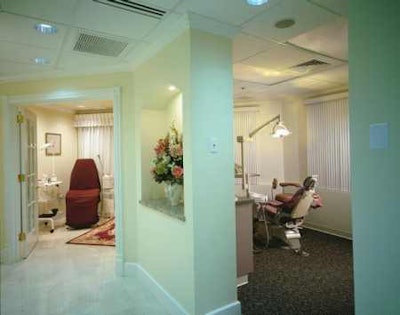 |
| Dr. Wynn Okuda's Honolulu office features stylish, inviting operatories. |
"We wasted a lot of time trying to take experienced hygienists and office staff and turn them into people with the right service mentality," says Dr. Landau. "Now we hire for personality, verbal skills, and personal presentation, and hopefully train them in the rest."
Dr. Okuda agrees.
"I don't hire for experience anymore, I hire for attitude," says Dr. Okuda. "You can't train someone to be nice or helpful - they're either born with it or they're not. I'd rather take someone with the right attitude who has no experience and train them to be a dental assistant."
Hiring friendly people isn't enough. You must train them in the basics of customer service and make sure they have the proper mindset.
"Creating a total patient experience goes way beyond being nice, smiling, and shaking hands," says Dr. Levin. "Your staff will need training in additional skill sets, such as communication and internal marketing. And they'll want to be compensated for it." He advises practices use bonuses to reward staff instead of higher salaries, to minimize fixed costs.
Such training should be ongoing, not just a one-time event.
"One day I took my staff to the Ritz Carlton for lunch," says Dr. Landau, who closes his office at least one day every quarter for staff training. "I wanted them to see what first-class service really looks like. Every person in the hotel - every waiter, every busboy, even the house cleaners - stops, looks you in the eye, and says hello. You don't get that kind of attention at your average mid-level Marriott. Or when you're shopping at Nordstrom and you pay for something, the cashier steps out from behind the register and hands it to you, face to face. We try to teach our staff that it's the extra warm fuzzies that make the difference."
Show Me the Money
Remodeling offices, renting limos and masseuses, and retaining talented office staff all cost money. Dr. Levin estimates a spa-style practice spends from 15 to 18 percent more than a traditional one on offices, personnel, and amenities.
The return on investment can be even greater - from 25 to 100 percent higher than normal, Dr. Levin says. But, he cautions, the risk of failure is also higher. Dentists must first have all their systems in place - from scheduling to insurance management to budgeting - and their staff adequately trained.
"Nobody's doing this out of the goodness of their heart," says Dr. Levin. "There are many reasons dentists want to pursue spa dentistry. They may determine this is their growth path or they're doing it to gain a competitive advantage for their practice. We work with our clients to ensure they do the right planning to help them make an excellent return on investment."
If you've got a rock star practice in Hawaii or LA, you might get away with recouping your costs by charging higher overall fees. But most dentists are limited by what the market will bear. Dr. Landau says most patients will notice the better care you provide and be willing to put up with slightly higher (say 20 percent higher) fees.
"The bottom line is that most people will pay more to be taken well care of," says Dr. Landau. "Even if they don't have the money now, they'll save up so they pay to be taken care of later."
The good news is that the trend toward concierge dentistry means patients are probably getting better care overall.
"If patients are more likely to have dental work because they like going to the dentist, they're more likely to get the preventative care they need," says Dr. Kimberly Harms of River Edge Dental. "Bottom line is making sure people are getting good care."
Even if you never plan to hire an office masseuse or give patients a hot wax, upscale dentistry is changing the expectations of many patients. Dentists who don't adjust their practices accordingly will pay the consequences.
"Whether you provide spa service or not, it's pressured the industry to become more service oriented, to treat not just the teeth but also the people attached to them," says Dr. Okuda.




